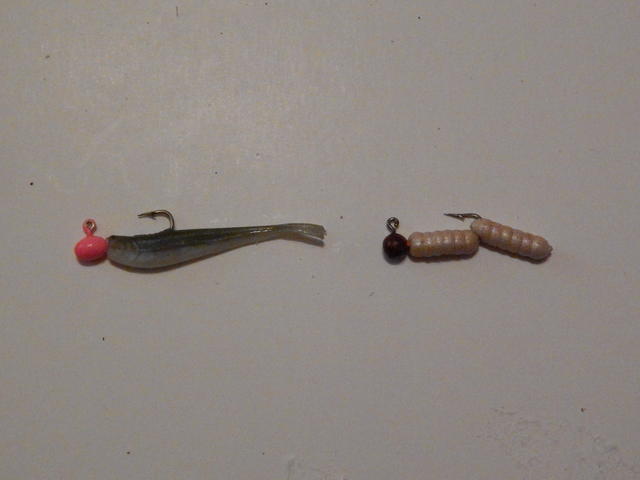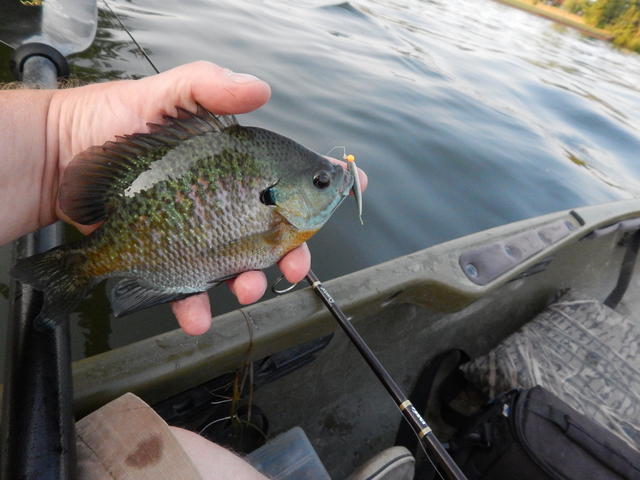Slow your jig down in cool water,and stop and let it sink,in warm water speed it up!
Sent from my iPad using Tapatalk
 Thanks: 0
Thanks: 0
 HaHa: 0
HaHa: 0
a super slow retrieve on bream is flat deadly ...the slow movement is perfect for the style of predator they are
plus if it keeps moving they dont get long to look it over and or sniff it out as a fake ....
use very light line and a very very small jig ......
sum kawl me tha outlaw ketchn whales
Eagle 1 LIKED above post
Slow your jig down in cool water,and stop and let it sink,in warm water speed it up!
Sent from my iPad using Tapatalk
I have been strictly a jig and artificial bait fisherman for the past 20 years or so, and will second all the tips given. Great advice.There are so many variables when jig fishing for panfish. I almost always use 4 pound line, unless fishing very stumpy waters with large panfish, then I will use 6 pound. Or when fishing extremely clear water where there is very little wood or heavy weeds, I will go down to two pound line. The jigs I use are 1/100 ounce, to 1/16 ounce, with the majority of them being 1/64 or 1/80 ounce. I have two primary presentations, hanging under a bobber, and retrieved without a bobber. Pretty cut and dry, or so it seems. All those variables I mentioned earlier start to come in when you consider weather, water flow, water clarity and color, water depth, and seasonal species activity, just to name a few. Presentations can vary drastically depending on what panfish you are after, and what style of jig/bait you are going to use. Teardrop style jigs are ideal for hanging under a bobber, or vertical jigging without a bobber, and using a serious of jigging and,or, twitching motions, hoping to replicate one of the many zooplankton that inhabit the waters all over the country. The standard round, lead head jigs, are ideal for both suspending under a bobber or vertical jigging, as well as casting and retrieving horizontally. Suspending a jig under a bobber, is just scratching the surface of the bobber fishing technique, for there are many variables in the technique itself. There are times when the fish don't want the jig moving, at all, so once I have figured that out, I just cast it to a likely panfish holding spot and let it sit. I don't touch it, because for some reason, if it moves they are not even going to taste it, let alone actually eat it. Some days, for some reason, the rig needs to be twitched, whereas other days, it actually needs to be retrieved slowly, while hanging under the bobber. Try all the presentations, because one of them will usually work once you get it in front of the fish. When jig fishing without a bobber, I again have two basic presentations, cast and retrieve, and vertical jigging, but, just like bobber fishing, there are variables. If I am casting and retrieving, I will either use a straight horizontal retrieve, or I'll jig it a foot or so up and down as I retrieve, once again depending on other things like fish species being targeted, water clarity, etc. By far, my favorite presentations or cast and straight horizontal retrieve for the majority of the season, and bobber fishing during the Spring and Fall, but I do use both techniques throughout the entire season. This video of mine gives a little look at how I go about it. And a couple pics of some of my panfish jigs.
https://youtu.be/mlhGn1CoV4g

It is not about the equipment you have to use,
It is about how you use the equipment you have. :D
Northern Michigan huh? Just about where at? I grew up In The area but now I'm a southerner lol. Grew up outside traverse city, manistee, scottsville and ludington. Anyways I would love to learn your bobber technique. Basically what I do now is make a 3-5 second 12 o'clock turn. It works sometimes but I just have this feeling it isn't the best practice. Nobody I know jigs so I'm learning everything for the first time.
I was raised in Grayling and spent the majority my life, 51 years, fishing all around Northern Michigan, with most of it being in the Grayling,Gaylord, Kalkaska, Roscommon, and Gladwin areas. When fishing jigs under bobbers, I always start high in the water column and work my way down. If I am fishing in 10 feet of clear water, I will set my jig 1 foot under the bobber to start. I'll cast it out and just let it sit for a couple minutes, without any motion at all. If nothing bites, I'll just shake my rod a bit until the bobber wiggles a bit, imparting just a little motion to the jig. I'll do that for a couple seconds and then let it sit again. Now if I get hit, then I'll continue that presentation, casting from an 8:00 to a 4:00 position around me until no more action. If I don't get a bite with the initial still/twitch presentation I will slowly reel my bobber about five or six feet. Sometimes this is when it gets hit and lets me know that they are high in the water and active. Once again, if it does not get hit, I will stop it for another minute or two and then repeat the same twitch, sit, move. I will use that presentation in several casts around me until the bites are done or I did not get any bites. If I did not get any bites, then I will lower the bait a foot or two and repeat the entire process until I have lowered my jig to within about a foot of the bottom. For the most part, I am fishing areas that I am confident of fish being present, so if I did the entire round of bobber/still/twitch, and had little or no action, I will raise the jig back up to about two feet from the bobber, cast it as far as possible, and then once the jig has settled under the bobber, I will steadily reel it in until it is back at the kayak, completing the same routine of lowering the jig, and, or, changing retrieval speed, until I have found the fish, or am convinced that they are not going to bite on a bobber rig. Then, before I move, I will grab my rod that is rigged with a jig and no bobber. My bobberless presentation is almost always a cast and retrieve method, starting at a foot or so under the surface, just like bobber fishing. Keep in mind that the attitude of the fish will often change, just like ours, so what works one day, or even one hour, might not work the next. Two different rigs always ready to go, and a willingness to put in the time, especially if you are pretty sure you are on fish, is extremely important to me, and probably my greatest asset when it comes to catching panfish. I have no problem sitting on a spot for 30 minutes to an hour if I am sure there are fish. Of all the jig presentations I use, the cast and steady retrieve is definitely my favorite other than right after ice out, the spawn, and just before freeze up, during which times I will use the bobber and jig rig. If you can find those little clear bobbers I show, definitely purchase them. I am a firm believer using rigs with clear bobbers usually catches more fish than the colored stick bobbers or round colored bobbers. Of course there are situations where it just doesn't matter, but to me, it's the clear bobbers or none. Here in Northern Michigan, many of the lakes, and other waterways are extremely clear, which is the main reason I started using the clear bobbers many years ago. I grew up fishing some of the best trout lakes, streams, and rivers in the country, and they are very, very clear. My grandfather taught me when I was quite young, that you could use a clear bobber with various flies, live baits, and lures, and could get a good cast without spooking the trout. Well as I got a bit older, and my passion for crappie and bluegills grew, it didn't take long to realize that if it could trick a trout then the clear bobber rig could definitely trick a panfish, so I incorporated the clear bobber trick into my panfishing arsenal. I hope this helps you out a bit more. Good luck.

It is not about the equipment you have to use,
It is about how you use the equipment you have. :D
I sure wished I had read that 5 hours ago. Cold Saturday rain pushed water temps down 7 degrees. I KNOW the fish were there. We caught two good fish. Was fortunate enough to release my biggest Shell Cracker ever. I also am grateful for the time taken to write that and the pictures taken. My knowledge and confidence has increased daily since I became a member here as well as my respect for the fish and fishermen.